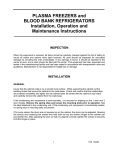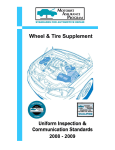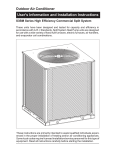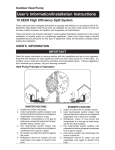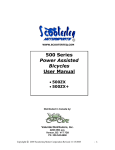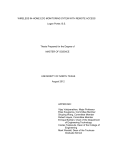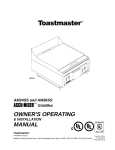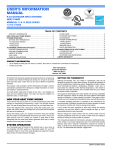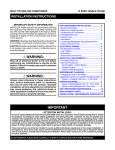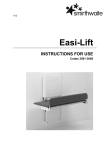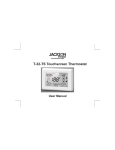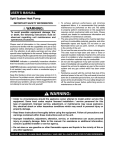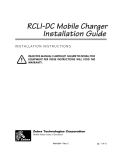Download 708144-A S3BA 10 SEER AC ii.pmd
Transcript
Outdoor Air Conditioner User’s Information and Installation Instructions 10 SEER Standard Efficiency Split System These instructions are primarily intended to assist qualified individuals experienced in the proper installation of heating and/or air conditioning appliances. Some local codes require licensed installation/service personnel for this type of equipment. Read all instructions carefully before starting the installation. These units have been designed and tested for capacity and efficiency in accordance with ARI Standards. Split System Air Conditioning units are designed for use with a wide variety of fossil fuel furnaces, electric furnaces, air handlers, and evaporator coil combinations. USER’S INFORMATION IMPORTANT Read this owner information to become familiar with the capabilities and use of your appliance. Keep this with literature on other appliances where you have easy access to it in the future. If a problem occurs, check the instructions and follow recommendations given. If these suggestions don’t eliminate your problem, call your servicing contractor. OPERATING INSTRUCTIONS To Operate Your Air Conditioner for Cooling — 1. Set the thermostat system switch to COOL or AUTO and the thermostat fan switch to AUTO. (See Figure 1) 2. Set the thermostat temperature to the desired temperature level by using the temperature selector. Please refer to the separate detailed thermostat user's manual for complete instructions regarding thermostat programming. The outdoor unit and indoor blower will both cycle on and off to maintain the indoor temperature at the desired cooling level. 2. Set the thermostat temperature to the desired temperature level by using the temperature selector. Please refer to the separate detailed user's manual for complete thermostat programming instructions. The furnace and indoor blower will cycle on and off to maintain the indoor temperature at the desired heating level. To Shut Off Your Air Conditioner — Set the thermostat system switch to OFF and the thermostat fan switch to AUTO. (See Figure 1) The system will not operate, regardless of the thermostat temperature setting. To Operate the Indoor Blower Continuously — Set the thermostat fan switch to ON (See Figure 1) The indoor blower will start immediately, and will run continually until the fan switch is reset to AUTO. The continuous indoor blower operation can be obtained with the thermostat system switch set in any position, including OFF. SYSTEM SWITCH FAN SWITCH To Operate Your Furnace for Heating — TEMPERATURE SCALES 1. Set the thermostat system switch to HEAT or AUTO and the thermostat fan switch to AUTO. (See Figure 1) TEMPERATURE SELECTOR Figure 1. Typical Thermostat The continuous indoor blower operation is typically used to circulate the indoor air to equalize a temperature unbalance due to a sun load, cooking, or fireplace operation. Read Your Warranty Please read the separate warranty document completely. It contains valuable information about your system. To Maintain Your Air Conditioner — ! CAUTION: Be certain the electrical power to the outdoor unit and the furnace/air handler is disconnected before doing the following recommended maintenance. 1. Regularly: a. Clean or replace the indoor air filter at the start of each heating and cooling season, and when an accumulation of dust and dirt is visible on the air filter. b. Remove any leaves and grass clippings from the coil in the outdoor unit, being careful not to damage the aluminum fins. c. Check for any obstruction, such as twigs, sticks, etc. ! CAUTION: Do not over-oil, or oil motors not factoryequipped with oil tubes. The compressor is hermetically “sealed” and does not require lubrication. 2. Before Each Cooling Season: If the furnace/air handler blower motor and the outdoor unit fan motor(s) have oil tubes at the motor bearings, apply 10 drops of SAE No. 20 motor oil to each oil tube. 3. Before Calling a Service Technician, Be Certain: a. The unit thermostat is properly set — see “To Operate Your Air Conditioner for Cooling” and “To Operate Your Furnace for Heating.” b. The unit disconnect fuses are in good condition, and the electrical power to the unit is turned on. 2 1. GENERAL INFORMATION Read the following instructions completely before performing the installation. Condensing Unit Section — Each condensing unit is shipped with a refrigerant charge adequate to operate the outdoor section with an indoor matching coil or air handler and 15 feet of refrigeration line. NOTE: DO NOT USE ANY PORTION OF THE CHARGE FOR PURGING OR LEAK TESTING. Liquid and Suction Lines — Refrigerant grade copper tubing should be used when installing the system. Refrigerant suction line tubing should be fully insulated to prevent condensate damage. Field Connections for Electrical Power Supply — All wiring must comply with the current provisions of the “National Electrical Code” (ANSI C1.) and with applicable local codes having jurisdiction. Size of electrical conductors and circuit protection must be in compliance with the information listed on the outdoor unit data label. 2. SAFETY CONSIDERATIONS Pressures Within the System — Split System Air Conditioning equipment contains liquid and gaseous refrigerant under pressure. Installation and servicing of this equipment should be accomplished by qualified, trained personnel thoroughly familiar with this type of equipment. Under no circumstances should the homeowner attempt to install and/or service the equipment without proper supervision from trained and qualified service personnel. ! WARNING: Ensure all electrical power to the unit is off prior to installing or servicing the equipment. Failure to do so may cause personal injury or death. Labels, Tags, Precautions — When working with this equipment, follow all precautions in literature, on tags, and on labels provided with the equipment. Read and thoroughly understand the instructions provided with the equipment prior to performing the installation and operational checkout of the equipment. Cantilever Mount — The cantilever mount should be designed with adequate safety factor to support the weight of the equipment, and for loads the mount is subjected to during operation. Installed equipment should be adequately secured to the cantilever mount and levelled prior to operation of the equipment. 3. SITE PREPARATION Roof Mount — The method of mounting should be designed so as not to overload roof structures nor transmit noise to the interior of the structure. Refrigerant and electrical lines should be routed through suitably waterproofed openings to prevent water leaking into the structure. Unpacking Equipment — Remove the cardboard carton and Literature Package from the equipment. Inspect for Damage — Inspect the equipment for damage prior to installing the equipment at the job site. Ensure coil fins are straight and, if necessary, comb fins to remove flattened and bent fins. Preferred Location of the Outdoor Unit at the Job Site — Conduct a survey of the job site to determine the optimum location for mounting the outdoor unit. Overhead obstructions, poorly ventilated areas, and areas subject to accumulation of debris should be avoided. The outdoor unit must be installed in such a manner that airflow through the coil is not obstructed and that the unit can be serviced. Facility Prerequisites — Electrical power supplied must be adequate for proper operation of the equipment. The system must be wired and provided with circuit protection in accordance with local building codes and the National Electrical Code. Minimum Circuit Ampacity — Electrical wiring to the equipment must be compatible and in compliance with the minimum circuit ampacity listed on the outdoor unit data label. Maximum Fuse/Circuit Breaker Size — Circuit protection for the outdoor unit must be compatible with the maximum fuse/circuit breaker size listed on the outdoor unit data label. 4. INSTALLING THE OUTDOOR UNIT Slab Mount — The site selected for a slab mount installation requires a stable foundation and one not subject to erosion. The slab should be level and anchored (if necessary) prior to placing the equipment on the slab. 5. INSTALLING THE INDOOR UNIT The indoor section of the unit should be installed before proceeding with the routing of refrigerant piping. Consult the Installation Instructions of the indoor unit (i.e., air handler, fan coil unit, etc.) for details regarding installation. 6. CONNECTING REFRIGERANT TUBING BETWEEN THE INDOOR AND OUTDOOR UNIT General Information — Once the outdoor and indoor unit placement has been determined, route the refrigerant tubing between the equipment in accordance with sound installation practices. Refrigerant tubing should be routed in a manner that minimizes the length of tubing and the number of bends in the tubing. Refrigerant tubing should be supported in a manner that the tubing will not vibrate or abrade during system operation. Tubing should be kept clean of foreign debris during installation and installation of a liquid line filter drier is recommended if cleanliness or adequacy of system evacuation is unknown or compromised. Every effort should be made by the installer to ensure that the field installed refrigerant containing components of the system have been installed in accordance with these instructions and sound installation practices so as to insure reliable system operation and longevity. The maximum recommended interconnecting refrigerant line length is 75 feet, and the vertical elevation difference between the indoor and outdoor sections should not exceed 20 feet. Optional Equipment — Optional equipment (i.e.: filter/driers, liquid line solenoid valves, etc.) should be installed in strict accordance with the manufacturer’s Installation Instructions. 3 For refrigerant line sets that incorporate single shot couplings only: 1. Remove protective caps from the unit and the refrigerant line couplings 2. Carefully wipe all coupling threads and seals with a clean cloth to remove any dust or foreign material which could contaminate the refrigerant system. 3. Using refrigerant oil, lightly lubricate the diaphragm, seal and threads on the male unit coupling. 4. Connect couplings as follows: a. b. HOLD REFRIGERANT LINE IN STRAIGHT POSITION TO UNIT COUPLING AND THREAD COUPLING HALVES TOGETHER BY HAND TO INSURE PROPER CONNECTION. Hold body of the line coupling hex, with wrench, while slowly tightening the union nut until a definite resistance (bottoming out) is felt. Mark the position of union nut (match lines on the line coupling and the unit bulk head), and then tighten the coupling an additional 1/4 turn to insure leak-proof connection. (See Table of Torque Values for recommended torque values if a torque wrench is used.) TABLE OF TORQUE VALUES Coupling Size 3/8” (10 mm) Liquid Line Coupling Torque 10 - 12 ft. lbs. (Metric: 14-16 N-m) 3/4” (19 mm) or 7/8” (22 mm) Vapor Line Coupling 34-45 ft. lbs. (Metric: 47-61 N-m) Service Valve Cap 5-6 ft. lbs. (Metric: 7-8 N-m) 7. MAKING ELECTRICAL CONNECTIONS ! WARNING: Turn off all electrical power at the main circuit box before wiring electrical power to the outdoor unit. Failure to comply may cause severe personal injury or death. 4 Wiring Diagram/Schematic — A wiring diagram/schematic is located on the inside cover of the electrical box of the outdoor unit. The installer should become familiar with the wiring diagram/schematic before making any electrical connections to the outdoor unit. Outdoor Unit Connections — The outdoor unit requires both power and control circuit electrical connections. Refer to the unit wiring diagram/schematic for identification and location of outdoor unit field wiring interfaces. Control Circuit Wiring — The outdoor unit is designed to operate from a 24 VAC control circuit. Control circuit wiring must comply with the current provisions of the “National Electrical Code” (ANSI C1.) and with applicable local codes having jurisdiction. Thermostat Connections — Thermostat connections should be made in accordance with the instructions supplied with the thermostat and with the instructions supplied with the indoor equipment. Electrical Wiring — Electrical wiring must comply with the current provisions of the “National Electrical Code” (ANSI C1.) and with applicable local codes having jurisdiction. Use of rain tight conduit is recommended. Electrical conductors shall have a minimum circuit ampacity in compliance with the outdoor unit rating label. The facility shall employ electrical circuit protection at a current rating no greater than that indicated on the outdoor unit rating label. Disconnect Switch — An electrically compatible disconnect switch must be within line of sight of the outdoor unit. This switch shall be capable of electrically de-energizing the outdoor unit. Optional Equipment — Optional equipment requiring connection to the power or control circuits shall be wired in strict accordance with current provisions of the “National Electrical Code” (ANSI C1.), with applicable local codes having jurisdiction, and the Installation Instructions provided with the equipment. Optional Equipment (i.e., liquid line solenoid valves, hard start kits, low suction pressure cutout switch kit, high pressure cutout switch kit, refrigerant compressor crankcase heater, etc.) should be installed in strict accordance with the manufacturer’s Installation Instructions. 8. START-UP AND CHECKOUT ! WARNING: Ensure electrical power to the unit is off prior to performing the following steps. Failure to do so may cause personal injury or death. Air Filters — Ensure air filters are clean and in place prior to operating the equipment. Thermostat — Set the room thermostat function switch to OFF, fan switch to AUTO, and move the temperature set-point to it’s highest setting. Short Cycle Protection (select models) — With the system operating in “Cooling” mode, note the temperature setting of the thermostat, and gradually raise the set-point temperature until the outdoor unit and indoor blower deenergize. Immediately lower the set-point temperature of the thermostat to it’s original setting and verify that the indoor blower is energized and that the outdoor unit remains deenergized. Verify that, after approximately 5 minutes, the outdoor unit energizes and that the temperature of the air supplied to the facility is cooler than ambient temperature. Outdoor Unit — Ensure the outdoor coil and top of the unit are free from obstructions and debris, and all equipment access/control panels are in place. Heating — If provided with heating equipment, lower the thermostat temperature to the lowest obtainable setting and set the thermostat function switch to “Heating." The indoor blower and outdoor unit should stop running. Increase the set-point temperature of the thermostat to the maximum setting. Verify that the heating equipment has been energized (i.e., fossil fuel burner operating, etc.) and that the indoor blower energizes after a short period of time. Feel the air being circulated by the indoor blower and verify that it is warmer than ambient temperature. Listen for any unusual noises. If present, locate and determine the source of the noise and correct as necessary. Functional Checkout: Adjustment of Refrigerant Charge: Prior to applying electrical power to the outdoor unit, ensure that the unit has been properly and securely grounded. Prior to applying electricity to the outdoor unit, ensure power supply connections have been made at the facility power interface and at the outdoor unit. ! CAUTION: If equipped with a refrigerant compressor crankcase heater, allow 24 hours prior to performing a function checkout to allow for heating of the refrigerant compressor crankcase. Failure to comply may result in damage and could cause premature failure of the system. Indoor Blower — Set the thermostat function switch to “Cooling” and the fan switch to ON or MAN. Verify that the Indoor Blower is operating and that airflow is not restricted. Set the fan switch back to Auto. ! WARNING: Split System Air Conditioning equipment contains liquid and gaseous refrigerant under pressure. Adjustment of refrigerant charge should only be attempted by qualified, trained personnel thoroughly familiar with the equipment. Under no circumstances should the homeowner attempt to install and/or service this equipment. Failure to comply with this warning could result in equipment damage, personal injury, or death. Cooling — Gradually lower the thermostat temperature set-point below the actual room temperature and observe that the outdoor unit and indoor blower energize. Feel the air being circulated by the indoor blower and verify that it is cooler than ambient temperature. Listen for any unusual noises. If present, locate and determine the source of the noise and correct as necessary. 5 NOTE: The Refrigerant Charging Charts are applicable to matched assemblies of our equipment and at listed airflows for the indoor coil. Assemblies of indoor coils and outdoor units not listed are not recommended and deviations from rated airflows or non-listed equipment combinations may require modifications to the expansion device(s) and refrigerant charging procedures for proper and efficient system operation. Refrigerant Charging Chart — Refer to Refrigerant Charging Charts for correct system charging and to Orifice Usage Chart for correct restrictor sizes. Optional Equipment — A functional checkout should be performed in specific accordance with the checkout procedures supplied with the equipment. 10 SEER SPLIT SYSTEM AIR CONDITIONER ORIFICE USAGE MODEL NUMBER SINGLE PHASE 1-1/2 Ton 2 Ton 2-1/2 Ton 3 Ton 3-1/2 Ton 4 Ton 5 Ton THREE PHASE 3 Ton 4 Ton 5 Ton RESTRICTOR SIZE (IN.) 0.051 0.060 0.063 0.067 0.075 0.080 0.093 SYSTEM CHARGE R-22 (OZ.) 63 64 68 69 87 102 114 0.067 0.080 0.092 69 102 114 REFRIGERANT CHARGING CHARTS FOR COOLING MODE OF OPERATION * Note: All pressures are listed in psig. and all temperatures in °F. — Discharge temperatures greater than charted values indicate a refrigerant undercharge. — Shaded Boxes indicate flooded conditions. — Rated Design Values. Suction Pressure will be lower than design value if indoor air flow entering dry bulb, or entering wet bulb temperatures are lower than design. S.P. = Suction Pressure L.P. = Liquid Pressure D.T. = Discharge Temperature 1-1/2 OUTDOOR TEMPERATURE ( °F ) TON 70 75 80 85 90 95 100 105 S.P. L.P. D.T. L.P. D.T. L.P. D.T. L.P. D.T. L.P. D.T. L.P. D.T. L.P. D.T. L.P. D.T. 71 73 75 77 79 81 83 85 87 89 91 93 95 97 6 178 180 182 184 187 151 156 161 164 168 193 195 197 200 202 154 159 163 167 171 208 210 213 215 218 157 162 166 170 174 223 226 228 231 234 237 160 165 169 173 177 181 238 241 244 247 250 252 163 168 172 176 180 184 253 256 259 262 265 268 166 171 175 179 183 187 268 272 275 278 281 284 169 173 178 182 186 190 284 287 291 294 297 300 172 176 181 185 189 193 REFRIGERANT CHARGING CHARTS FOR COOLING MODE OF OPERATION - Continued 2 OUTDOOR TEMPERATURE ( °F ) TON 70 75 80 85 90 95 100 105 S.P. L.P. D.T. L.P. D.T. L.P. D.T. L.P. D.T. L.P. D.T. L.P. D.T. L.P. D.T. L.P. D.T. 69 71 73 75 77 79 81 83 85 87 89 91 93 95 192 194 196 198 201 160 165 170 173 176 208 210 212 215 218 163 167 172 176 179 224 227 229 232 234 166 170 175 179 182 240 243 245 248 251 254 168 173 178 182 185 189 256 259 262 265 268 271 171 176 180 184 188 192 273 276 279 282 285 287 174 179 183 187 191 195 289 292 295 298 301 304 177 182 186 190 194 198 305 308 312 315 318 321 180 184 189 193 197 201 2-1/2 OUTDOOR TEMPERATURE ( °F ) TON 70 75 80 85 90 95 100 105 S.P. L.P. D.T. L.P. D.T. L.P. D.T. L.P. D.T. L.P. D.T. L.P. D.T. L.P. D.T. L.P. D.T. 67 69 71 73 75 77 79 81 83 85 87 89 91 93 193 194 196 198 201 159 164 168 173 176 209 211 213 215 218 162 167 172 176 180 225 228 230 232 235 166 171 176 180 183 242 244 247 250 252 255 170 174 179 183 187 191 258 261 264 267 270 273 173 178 182 186 190 194 275 278 281 284 287 290 177 181 186 190 194 198 292 295 299 301 304 307 180 185 189 193 197 201 309 312 316 319 322 325 184 188 193 197 201 205 3 OUTDOOR TEMPERATURE ( °F ) TON 70 75 80 85 90 95 100 105 S.P. L.P. D.T. L.P. D.T. L.P. D.T. L.P. D.T. L.P. D.T. L.P. D.T. L.P. D.T. L.P. D.T. 67 69 71 73 75 77 79 81 83 85 87 89 91 93 198 200 201 204 206 166 171 176 180 183 214 216 218 221 223 170 174 179 183 186 231 233 235 238 241 173 178 182 186 190 247 249 252 255 258 260 176 181 185 189 193 197 263 266 269 272 275 278 179 184 188 192 196 200 280 283 286 289 292 295 183 187 192 196 200 204 296 300 303 306 309 312 186 190 195 199 203 207 313 316 320 323 326 329 189 193 198 202 206 210 7 REFRIGERANT CHARGING CHARTS FOR COOLING MODE OF OPERATION - Continued 3-1/2 OUTDOOR TEMPERATURE ( °F ) TON 70 75 80 85 90 95 100 105 S.P. L.P. D.T. L.P. D.T. L.P. D.T. L.P. D.T. L.P. D.T. L.P. D.T. L.P. D.T. L.P. D.T. 66 68 70 72 74 76 78 80 82 84 86 88 90 92 190 192 193 194 197 160 165 169 175 179 205 207 209 211 214 163 168 173 178 181 220 223 225 227 230 166 171 176 180 184 236 238 241 244 247 249 169 174 179 183 187 190 252 255 257 260 263 266 172 177 182 186 190 193 268 271 274 277 280 283 175 180 184 188 192 196 284 287 290 293 296 299 178 183 187 191 195 199 300 304 307 310 313 316 181 186 190 194 198 202 4 OUTDOOR TEMPERATURE ( °F ) TON 70 75 80 85 90 95 100 105 S.P. L.P. D.T. L.P. D.T. L.P. D.T. L.P. D.T. L.P. D.T. L.P. D.T. L.P. D.T. L.P. D.T. 65 67 69 71 73 75 77 79 81 83 85 87 89 91 5 TON S.P. 59 61 63 65 67 69 71 73 75 77 79 81 83 85 192 194 195 195 198 143 148 153 161 164 70 L.P. D.T. 175 177 179 180 183 150 155 160 169 172 208 210 212 213 216 149 154 158 165 168 75 L.P. D.T. 193 195 198 199 202 156 161 166 173 176 ¢708144$¤ 708144A 225 228 230 232 235 155 159 164 169 173 243 245 248 250 253 256 160 165 170 174 178 182 261 263 266 269 272 275 166 170 175 179 183 187 279 282 285 288 291 294 171 176 180 184 188 192 OUTDOOR TEMPERATURE ( °F ) 80 85 90 95 L.P. D.T. L.P. D.T. L.P. D.T. L.P. D.T. 211 214 216 217 221 162 167 171 177 180 230 232 234 236 240 243 168 172 177 181 185 189 248 250 252 255 258 262 173 177 182 186 190 194 266 268 270 274 277 280 178 183 187 191 195 199 297 300 304 306 309 312 177 181 185 189 193 198 100 L.P. D.T. 284 286 288 292 296 299 184 188 192 196 200 204 316 319 323 325 328 331 182 186 191 195 199 203 105 L.P. D.T. 302 304 306 311 314 318 188 192 196 201 206 210 INSTALLER: PLEASE LEAVE THESE INSTALLATION INSTRUCTIONS WITH THE HOMEOWNER. 708144A (Replaces 7081440) Specifications and illustrations subject to change without notice and without incurring obligations. Printed in U.S.A. (02/03)








